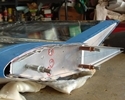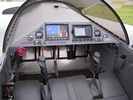


random user submitted photo
Losing the training wheel.
Re: Losing the training wheel.
I want to urge my fellow Trigear pilots to not look down their nose at those who continue to drag their tails. There are many pilots who simply cannot maser the trigear, and it should not be a source of ridicule or shame when these aviators do the prudent thing and revert to the "conventional" gear.
I recall the words of Chuck Yeager--"Yes, I was a combat flier, did pretty well in P-51s and in doing some testing of new airplanes. But I became a real pilot when I mastered the trigear. Lots of good P-51 pilots couldn't do it." (I'm pretty sure he wrote that, it might have been Bob Hoover).
When aviation made the jump from real "air fields" to "runways", the rationale for taildraggers fell away along with the ability to always take off and land with a headwind. The better, more flexible trigear was developed and aviation never looked back. But, as Art Scholl wrote "there were some guys who just couldn't "get" the trigear, could never master the higher available AoA on takeoff and landing. It's just hotter and more challenging. For those guys I'm glad we've still got the taildraggers with that nice, big triangular base. Some of these guys are still good pilots-- slower reflexes, sure, but nice guys. It would be a shame to lose them just because airplane design left them behind." (I think that was Art Scholl, maybe it was Jimmy Doolittle).
For those who take the small step back to the older taildragger form, the FAA helpfully mandates the additional remedial hours of instruction for the so-called "taildragger endorsement." Yes, the accident statistics and insurance rates give objective testimony to the continued troubles these pilots continue to have, but imagine how much worse the situation would be without the remedial training!
Sonex taildragger:
[img]

Sonex Trigear

Anyway, whether we choose to fly taildragger or trigear, the important part is the flying, not the 2% of the time we spend with the wheels on the ground.
(Tongue firmly in cheek)
Mark Waldron
I recall the words of Chuck Yeager--"Yes, I was a combat flier, did pretty well in P-51s and in doing some testing of new airplanes. But I became a real pilot when I mastered the trigear. Lots of good P-51 pilots couldn't do it." (I'm pretty sure he wrote that, it might have been Bob Hoover).
When aviation made the jump from real "air fields" to "runways", the rationale for taildraggers fell away along with the ability to always take off and land with a headwind. The better, more flexible trigear was developed and aviation never looked back. But, as Art Scholl wrote "there were some guys who just couldn't "get" the trigear, could never master the higher available AoA on takeoff and landing. It's just hotter and more challenging. For those guys I'm glad we've still got the taildraggers with that nice, big triangular base. Some of these guys are still good pilots-- slower reflexes, sure, but nice guys. It would be a shame to lose them just because airplane design left them behind." (I think that was Art Scholl, maybe it was Jimmy Doolittle).
For those who take the small step back to the older taildragger form, the FAA helpfully mandates the additional remedial hours of instruction for the so-called "taildragger endorsement." Yes, the accident statistics and insurance rates give objective testimony to the continued troubles these pilots continue to have, but imagine how much worse the situation would be without the remedial training!
Sonex taildragger:
[img]

Sonex Trigear
Anyway, whether we choose to fly taildragger or trigear, the important part is the flying, not the 2% of the time we spend with the wheels on the ground.
(Tongue firmly in cheek)
Mark Waldron
Last edited by vigilant104 on Sat Dec 21, 2013 1:23 pm, edited 1 time in total.
Mark Waldron
Sonex 1230 (Builder: Jay Gibbs)
Aerovee, Trigear
Sonex 1230 (Builder: Jay Gibbs)
Aerovee, Trigear
- vigilant104
- Posts: 265
- Joined: Wed Nov 09, 2011 3:34 pm
- Location: Near Dayton, OH
Re: Losing the training wheel.
vigilant104 wrote: There are many pilots who simply cannot maser the trigear, and it should not be a source of ridicule or shame when these aviators do the prudent thing and revert to the "conventional" gear.
Mark Waldron
I guess I must admit my reasons for going to the tail dragger from the tri-gear ...
I figured that since I made John Monnett upset by hanging a Corvair engine on his aircraft design the least I could do is remove that offending appendage from the front that he doesn't like very much. Perhaps that will put me back, somewhat, into his good graces ...
8~)
Dale
N319WF
http://kitplanes2.com/blog/2013/12/ownerbuilder-2/
-

daleandee - Posts: 877
- Joined: Fri Feb 01, 2013 6:14 pm
Re: Losing the training wheel.
It took me a little bit to convert to flying tricycle gear. When I was a kid my first landing in a C172 I managed to wheelbarrow it on. That was from 100 hours of mostly wheel landings. I did manage to put it on very straight, and very gentle, but it sure riled up the instructor. There were a few other things it took me a year to get used to that I didn't have before - flaps, side by side seating, artificial horizon and DG, radios that worked and so on. Regarding Mark's well written manifesto on not looking down on tailwheel pilots, a chief tow pilot in my first glider club flew Starfighters. He was also a big tailwheel guy. His personal airplane was a 172 though.
The conversion pictures look great! Keep them coming!
The conversion pictures look great! Keep them coming!
Bryan Cotton
Poplar Grove, IL C77
Waiex 191 N191YX
Taildragger, Aerovee, acro ailerons
dual sticks with sport trainer controls
Prebuilt spars and machined angle kit
Year 2 flying and approaching 200 hours December 23
Poplar Grove, IL C77
Waiex 191 N191YX
Taildragger, Aerovee, acro ailerons
dual sticks with sport trainer controls
Prebuilt spars and machined angle kit
Year 2 flying and approaching 200 hours December 23
-

Bryan Cotton - Posts: 5496
- Joined: Mon Jul 01, 2013 9:54 pm
- Location: C77
Re: Losing the training wheel.
She's a taildragger.
Installed the new mount and gear legs. Surprisingly, no mods to the firewall except plugging the nose wheel hole for the steering rod.
Installed the new mount and gear legs. Surprisingly, no mods to the firewall except plugging the nose wheel hole for the steering rod.
Last edited by fastj22 on Sat Dec 28, 2013 9:46 am, edited 1 time in total.
John Gillis
SEL Private, Comm Glider, Tow pilot (Pawnee Driver)
Waiex N116YX, Jabiru 3300, Tail dragger,
First flight, 3/16/2013. 403 hours and climbing.
Home: CO15. KOSH x 5
Flying a B-Model Conversion (Super Bee Baby!)
-

fastj22 - Posts: 1594
- Joined: Sun Aug 21, 2011 5:56 pm
- Location: Mile High
Re: Losing the training wheel.
Excellent!
Bryan Cotton
Poplar Grove, IL C77
Waiex 191 N191YX
Taildragger, Aerovee, acro ailerons
dual sticks with sport trainer controls
Prebuilt spars and machined angle kit
Year 2 flying and approaching 200 hours December 23
Poplar Grove, IL C77
Waiex 191 N191YX
Taildragger, Aerovee, acro ailerons
dual sticks with sport trainer controls
Prebuilt spars and machined angle kit
Year 2 flying and approaching 200 hours December 23
-

Bryan Cotton - Posts: 5496
- Joined: Mon Jul 01, 2013 9:54 pm
- Location: C77
Re: Losing the training wheel.
If I ever own an airplane with a nosewheel, it shall retract to be hidden from view thus saving I from embarrassment.
:D
:D
Kip
2010 Waiex 0082 (first flight May 2010)
Jabiru 3300 #1637 and #3035
Dynon D-180
Becker radios
Garmin GDL 82 ADS-B
1175 hours
48 states visited
Based near Atlanta
Also flying a...
2000 Kolb Firestar II, Rotax 503, 575 hours
2010 Waiex 0082 (first flight May 2010)
Jabiru 3300 #1637 and #3035
Dynon D-180
Becker radios
Garmin GDL 82 ADS-B
1175 hours
48 states visited
Based near Atlanta
Also flying a...
2000 Kolb Firestar II, Rotax 503, 575 hours
- N111YX
- Posts: 711
- Joined: Fri Jun 03, 2011 9:43 am
- Location: Atlanta, GA USA
Re: Losing the training wheel.
Quick, somebody get Kip one of those shirts!
I wonder if anybody has made a nosewheel Pitts. Could be unique.
I wonder if anybody has made a nosewheel Pitts. Could be unique.
Bryan Cotton
Poplar Grove, IL C77
Waiex 191 N191YX
Taildragger, Aerovee, acro ailerons
dual sticks with sport trainer controls
Prebuilt spars and machined angle kit
Year 2 flying and approaching 200 hours December 23
Poplar Grove, IL C77
Waiex 191 N191YX
Taildragger, Aerovee, acro ailerons
dual sticks with sport trainer controls
Prebuilt spars and machined angle kit
Year 2 flying and approaching 200 hours December 23
-

Bryan Cotton - Posts: 5496
- Joined: Mon Jul 01, 2013 9:54 pm
- Location: C77
Re: Losing the training wheel.
N111YX wrote:If I ever own an airplane with a nosewheel, it shall retract to be hidden from view thus saving I from embarrassment.
:D
I knew you were thinking SubSonex!! :mrgreen:
Mike Farley
Waiex #0056 - N569KM (sold)
Onex #245
Waiex #0056 - N569KM (sold)
Onex #245
- MichaelFarley56
- Posts: 1485
- Joined: Thu Jun 02, 2011 11:38 pm
- Location: Columbus, Ohio
Re: Losing the training wheel.
You're on to me Mike.
And Bryan, I just threw up a little imaging the sight of a nosewheel equipped S-1.
Tonight, I will not sleep.
And Bryan, I just threw up a little imaging the sight of a nosewheel equipped S-1.
Tonight, I will not sleep.
Kip
2010 Waiex 0082 (first flight May 2010)
Jabiru 3300 #1637 and #3035
Dynon D-180
Becker radios
Garmin GDL 82 ADS-B
1175 hours
48 states visited
Based near Atlanta
Also flying a...
2000 Kolb Firestar II, Rotax 503, 575 hours
2010 Waiex 0082 (first flight May 2010)
Jabiru 3300 #1637 and #3035
Dynon D-180
Becker radios
Garmin GDL 82 ADS-B
1175 hours
48 states visited
Based near Atlanta
Also flying a...
2000 Kolb Firestar II, Rotax 503, 575 hours
- N111YX
- Posts: 711
- Joined: Fri Jun 03, 2011 9:43 am
- Location: Atlanta, GA USA
Re: Losing the training wheel.
Busy new years day.
Twas the day of the new year and all through the hangar,
Not a creature was stirring, not even a mouse.
The engine was hung from the new mount with care,
In hopes a flying Waiex soon would be there.
Seems my transformation to tail dragger is exceeding my ability to gain my endorsement.
Engine rehung. All probes re-attached to the RDAC.
Brakes installed and re-plumbed.
I haven't tried the cowl, I suspect it will be my nemesis.
Instructor returns from holiday this week. I hope weather holds to get my endorsement soon to follow.
Sorry, no pictures today.
Twas the day of the new year and all through the hangar,
Not a creature was stirring, not even a mouse.
The engine was hung from the new mount with care,
In hopes a flying Waiex soon would be there.
Seems my transformation to tail dragger is exceeding my ability to gain my endorsement.
Engine rehung. All probes re-attached to the RDAC.
Brakes installed and re-plumbed.
I haven't tried the cowl, I suspect it will be my nemesis.
Instructor returns from holiday this week. I hope weather holds to get my endorsement soon to follow.
Sorry, no pictures today.
John Gillis
SEL Private, Comm Glider, Tow pilot (Pawnee Driver)
Waiex N116YX, Jabiru 3300, Tail dragger,
First flight, 3/16/2013. 403 hours and climbing.
Home: CO15. KOSH x 5
Flying a B-Model Conversion (Super Bee Baby!)
-

fastj22 - Posts: 1594
- Joined: Sun Aug 21, 2011 5:56 pm
- Location: Mile High
Who is online
Users browsing this forum: No registered users and 12 guests







